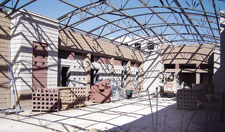Construction prices are rising along with soaring real-estate prices, driving the Manhattanization of the city. But in the tight market, local bidders are choosing their targets while the high-rise growth is attracting outsiders with experience in vertical construction.
|
Since 2000, Clark County has grown by 401,940 people, roughly the population equivalent of Oakland, Calif. By 2024, Jeff Hardcastle, Nevadas state demographer, expects the county to reach 2.75 million residents, 36.3% more than today. The newcomers have fueled a robust housing market that saw a record 38,517 new single-family detached home sales in 2005, up 30.7% from the previous year, reports Dennis Smith, president of Home Builders Research Inc., Las Vegas. The median new single-family detached home sold for $345,130 in 2005, 53.1% more than just five years ago, he says.
Clark County land values have risen more than 300% in the last four years, with asking prices now ranging from $900,000 to $1 million per acre, say local builders. The 2002 stock market contraction drove many people to invest in real estate, resulting in a flood of REIT and speculation activity, says John Restrepo, principal of Restrepo Consulting Group, a Las Vegas real-estate research firm.
 |
| School Daze. Billions of dollars spent, billions more to come on education facilities for fast-growing area. (Photo courtesy of Clark County School District) |
Under provisions of a 1998 local law, the U.S. Bureau of Land Management is divesting federal lands in Clark County. To date, 13,000 acres of government land have passed into private hands. The auction monies are returned to the state General Education Fund and Southern Nevada Water Authority as well as parks and protecting environmentally sensitive areas. Yet some developers still feel the process is too slow to keep pace with the rate of growth.
Ron Lynn, building director for Clark County Development Services, agrees. We have had a series of record years, virtually unending growth since 1983, he says. This cycle starts with residential building, which drives commercial expansion. The tight land market is fueling a vertical building boom in the Vegas Valley, which until recently had been defined by urban sprawl. There are 107 mid- and high-rise condo and condo-hotel projects, totaling 79,000 units, proposed, planned or under construction in the Las Vegas Valley, says Restrepo.
|
Nearly $25 billion worth of resort expansions are planned by 2009, the Las Vegas Convention and Visitors Authority reports. Another $6.45 billion worth of projects are tentatively proposed through 2009. Topping them all will be MGM Mirage Inc.s Project CityCenter development, a $7-billion, 18-million-sq-ft hotel, condominium, casino and entertainment complex (ENR 12/5/05 p. 16). Main resort construction will begin in April, with a phased opening in 2009 and 2010. But the condo market is starting to show signs of exhaustion in the face of soaring real-estate costs. In July, one developer canceled a $600-million condo-hotel project; last month saw cancellation of a $325-million condo. Other developers are flipping properties rather than build (ENR 1/23 p. 15).
 |
| Mismatched. Population growth has been rapid in Clark County, but electricity demand has grown even faster, reflecting intense use of power for air conditioning, computers and other devices of modern life. Assembly Bill 3, passed last year, requires utilities to encourage efficient use of energy among customers to reduce demand growth. By 2015, 20% of utility retail sales must be renewable energy or energy-efficiency reductions. |
Labor Gains
CityCenter construction will employ over 7,000 workers at peak activity, or about one-third of southern Nevadas total building trade work force, says Richard Rizzo, chairman of Perini Building Co., a unit of Perini Corp., Framingham, Mass. The company has been importing workers from out-of-state, paying 10 to 15% over scale, plus moving expenses, to ramp up manpower.
Local trade unions are gaining enrollment across the board. We increased our membership by 900 to 1,200 people last year, says Tommy White, secretary-treasurer for the Laborers Local 872, which represents over 4,000 members in Clark County. And were projecting to add up to 2,000 more members by 2007. The Laborers chartered a new local, 702, in November for light-commercial and residential work.
Both the carpenters and the laborers allow migration where needed without penalizing members or levying additional dues. The Southwest Regional Council of Carpenters has around 8,800 people in Clark County, a number that is expected to top 10,000 during 2006-07, says Marc Fuhrman, the councils senior administrative assistant. Its the guys from the Rust Belt, places like Michigan, Wisconsin and Ohio, who are coming to Las Vegas, he says.
The overheated construction market has sparked intense competition for labor, contractors and materials. Contractor demand for project managers and management staff has resulted in poaching among local firms, a disturbing practice that has strained relations among subcontractors and rivals, says Frank Martin, president and CEO of Martin-Harris Construction, Las Vegas. His firm uses recruiters and national ads to secure new management talent, but keeps locals off limits. Martin-Harris, like others, pays moving and living expenses, and offers signing bonuses to get top recruits.
Shoving Numbers Out
The bidding climate too has changed. Many companies prefer private-negotiated work over the traditional low-bid approach in public jobs.
Contractors are just shoving numbers out there with high profit margins because they have so much work, says Tim Lockett, assistant construction director...
ike a middle-aged rake too long on the party circuit, Las Vegas is starting to show the strain of 20 years of unrelieved excess. Roads are congested, schools crowded, water supplies dwindling and the pressures of growth are distorting the market for construction labor and contracting capacity.

Post a comment to this article
Report Abusive Comment